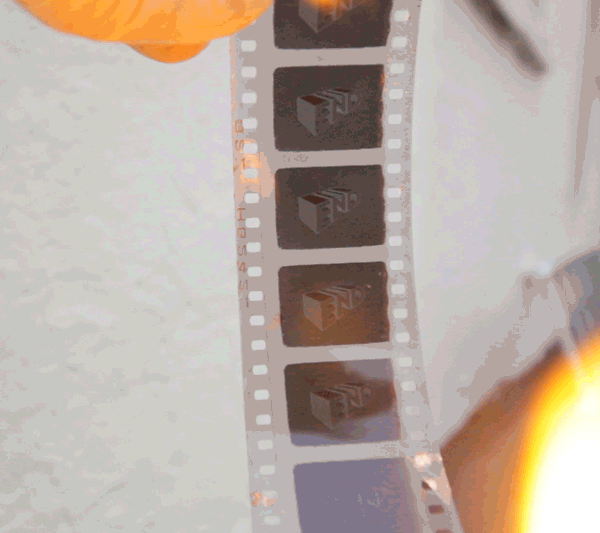Aleatoric Imagemaking

NITRATE
The journey of a lost can of film.
From discovery to destruction.
Scroll to the bottom of the page to see the results in full.
Rusty Rubbish?
Round at Lovely Olivia’s building was a pile of stuff someone had left by the front door.
Presumably they’d moved out or didn’t want it as it was still there after a few visits.
When I spotted the rusty diamond in the junky rough, opened it and found film within, I obviously got a lil excited. Olivia said I may as well take it...

Toxic Treats
Eco-Friendly Design
This treasure find was especially exciting once I spotted the words ‘NITRATE FILM’ written down the edge of the film, with the disarmingly cute combustible symbol.

Nukin' Nazis
Nitrate film is well flippin’ dangerous Fam.
At least it can be if not cared for in the right conditions.
Or deliberately set ablaze to kill Nazis.
Quite right.
(Right).

[Still from Tarantino's Inglourious Basterds. Obviously not my copyright.]
Screening Silver
I’d been to a season of nitrate film screenings at the British Film Institute, London in 2010 and it was ruddy amazing. I got to see Brighton Rock (1947) as my first Nitrate experience and it blew my tiny mind. I also saw the same print six years later at the Nitrate Picture Show at the Dryden Theatre, Rochester New York and it still dazzled. There's a silvery-ness to a nitrate print.
There's also the heightened experience of seeing something so dangerous, yet so beautiful. Like every frame that passes the lamp of the projector without going up in flames is a tiny miracle. Twenty-four miracles every second.
As the only place in the U.K. equipped to show the format (with diddy fire extinguishers built into the projector being one equipping), the BFI don’t do it nearly enough for my taste. They seem to favour gross 4K so-called “restorations” over showing the films in the way they were seen upon release.
But that’s a gripe for another rambly essay.

Naval Nitrate
During this nitrate season the BFI showed an old naval training film in their lobby. The flick was used to train sailorboys to deal with nitrate film fires and it’s pretty bonkers to watch.
It shows every type of fire extinguisher failing to quash the blaze, even a thick fire blanket doesn’t do much. A nitrate fire can re-ignite itself just by the fumes. Flammable air.
So after four or five years of that found can living under my bed, I decided to start the process of seeing what was on the film and try to preserve it in some way. Then also make the neighbourhood a bit safer by disposing of the nutty noxious nitrate.
Dicky Attenborough in Brighton Rock (1947).
Puzzled Parsnips
Official recommendations for the handling of found nitrate film all seemed to end in destruction. If the thing was so far gone that it would have to be destroyed (as this was) there was no way I was going to let the fire brigade or the council have all the fun.
I lived near the beach so I figured I was best placed to do the disposing myself. By natures largest fire extinguisher: the flippin' sea.
Press play on the below extract from Episode 19 of the Athletico Parsnips Podcast to hear
Andy Dawson & Bob Mortimer answer my listener’s question about how I should dispose of the film.
Sad Snippings
With the relatively safe send-off for the film planned, I set about trying to capture the images. I’d recently invested in a film scanner for 35mm and 120 stills film and this seemed my best chance of capturing any images at a high quality, even if only in a digital format.
Of course, as we all know, no digital format has ever bettered photo chemical film for quality, or indeed long-term storage.
But in this case, it seemed like digital or death.
My scanner will scan two sets of six exposures on 35mm film at a time. That is, when taken on a ‘normal’ 35mm stills camera. These shoot along the film horizontally, with sprocket holes running above and below the images.
A movie camera shooting onto 35mm film does so vertically, so the holes run down the sides of the images. That also means smaller images, therefore more pics per scan when using a photo scanner. Double in fact.

With a heavy heart, I cut the film into strips of 12 frames and scanned them in pairs.
It didn’t feel great to be desecrating this bit of history; I knew this film must be at least eighty years old.
But it was this or let it keep rotting until there’s nothing left at all.
I’d say there was possibly a third of the can that was completely unsalvageable. Gummed together and rotten.


Fume Funk
I scanned what I could of the can over the course of a week. Across the first few nights I would burn what I scanned that day in an old tin, carefully, short snips at a time. It was easy to see how, back in the day, this stuff had caused so much chaos and in some disasters: death. It goes up like a motherfucker.
And the fumes.. oh boy. This whole enterprise was happening during the first lockdown so I had plenty of face masks around. Being the doofus that I am, I thought that doubling up some thick ones would be enough whilst burning but obviously that made no difference. My lungs felt pretty rough for a good few weeks after.

Carrier Coffin
On the last night, I had a carrier bag’s worth of scanned snips and headed for the beach. It seemed fitting to send them off in their home for the past decades so I clumped it all in the tin, and said goodbye. I wish wish wish I’d set up a better camera to capture the final cremation but it’s just the below naff phone video. I obviously wasn’t prepared for the ten foot inferno as the top’s cut off.
Press play on the video below to see the final send off.
.jpg)
Gunky Gold
I had a fantastic week, I tell ya.
Much of the film had deteriorated so badly that it was unsalvageable. Particularly the main bulky roll. It looked like something from the bottom of the sea.
Some footage, as you’ll see, shows scratchy patches down the middle, these were sections that had been stuck to each other and peeled away, removing some emulsion (containing the image) in the process. Some of these sections were scanned without attempting to unstick, leaving two or three layers of images on top of each other in a mad collage of science and industry.


Some of the film was in short rolls, including the only clip that was a positive image- ripe for projection. The couple dancing.
Everything else was negative, which made me wonder if it was original camera footage, rather than something mass produced.
Then came the investigations...
London Lab
The first clue was the clip of this building.
I knew it was London. I recognised it from a 3 AM race I once ran against a night bus to the next stop. With exploding chest and panting I thought, ‘nice curves’ as I passed.
I used one of them there internet map things to confirm exactly where it was and got some street names to dig around with.
I found out it was built as a laboratory by the Metropolitan Water Board in 1938. The M.W.B. was a precursor to the Thames Water Authority which was then privatised (gross) into the present Thames Water.
The building is at the head of the subterranean New River; a great spot for watery goings-on for hundreds of years. Right over the road is the dance theatre Sadlers Wells, so named for it’s well-y past.
The building is just flats now but there's some lovely gardens you can go have a mooch round.
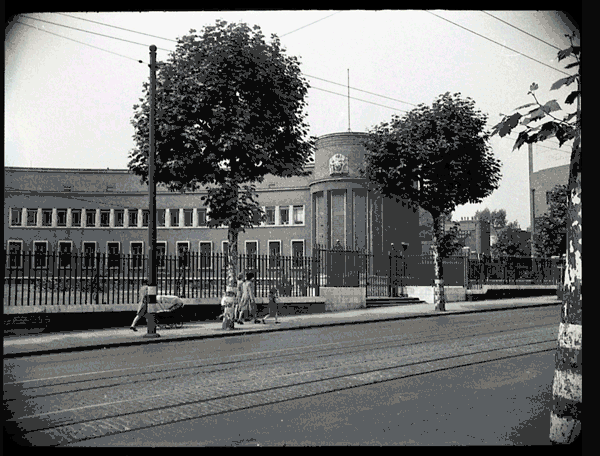

Looking at the footage with the Metropolitan Water Board in mind helped unlock many other shots from the can. The bizarre microscopic images and the white coated boffins in the lab made sense now that we knew this building was a water testing facility. The staircase shots helped tie that big tiled curve to the exterior view.
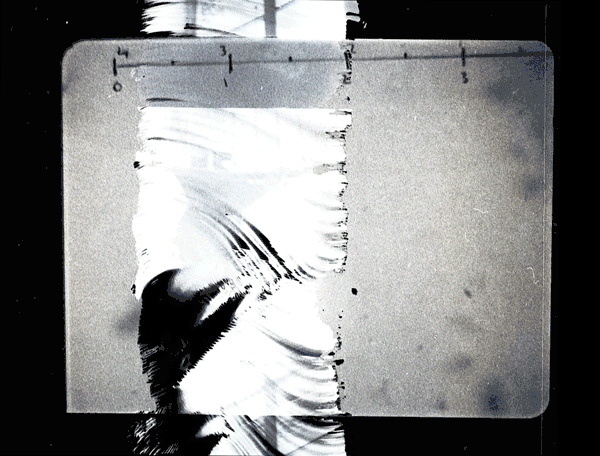
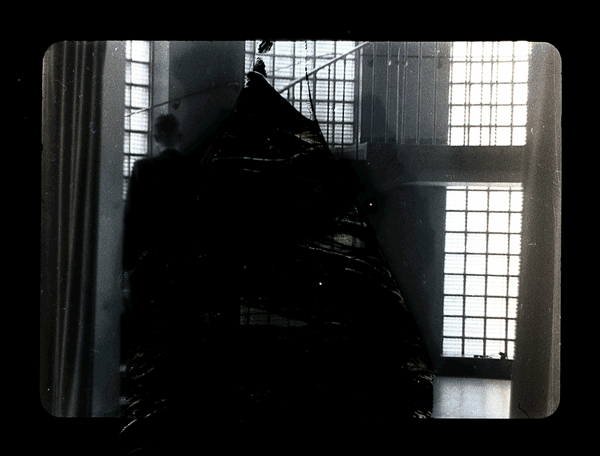
This location was double donkey confirmed by the footage of the company vans passing through the back gate, and the presence of the Shakespeare’s Head pub in the background, the essence of which is still there, in a way; the current iteration was rebuilt in the 1960’s
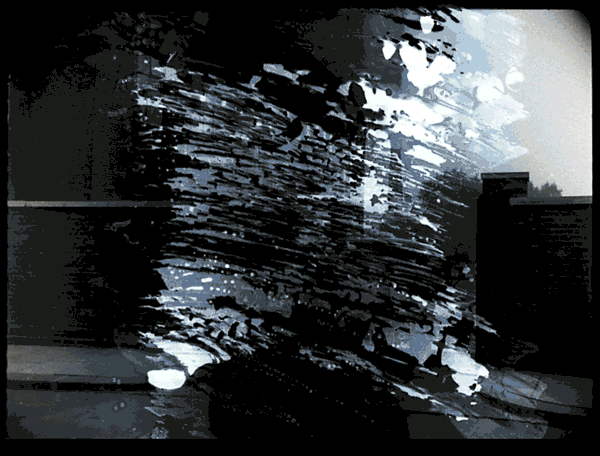


Pathé Patty
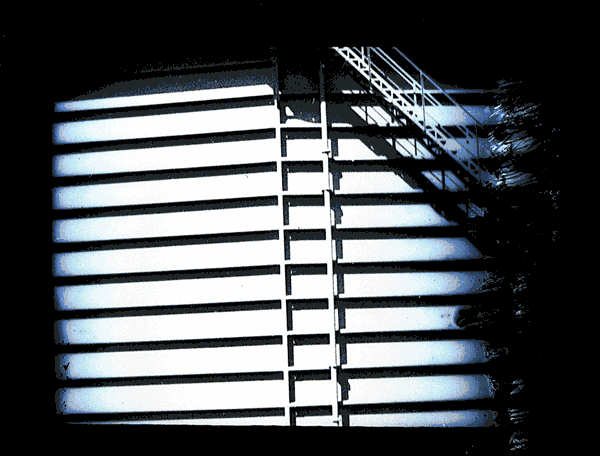
The tower seen here was part of a M.W.B. facility at Nine Elms near Battersea, South London. The power station can be seen in the background before it was expanded from two, to the four chimneyed icon we know today. This view begins to close the window down on when this footage could have been taken.
I believe this tower was on the site of the present day
Heathwall Pumping Station.
But what of the bizarre patties on conveyor belts?
I found a Pathé newsreel on the Youtube called “Water Works” from 1949 which has similar footage of lads building a reservoir in Chingford. Presumably these patties are bricks being made- or concrete blocks, or even the filtration bricks seen around 1:39 in the Newsreel (linked in blue above).
These resevoir works could also explain the huge blazing kilns. Water, Earth, Fire, Film. All the key elements. Pretty rad right?
The date of this newsreel, again helps narrow down our time frame, if not place it exactly at the same time as that production. Could it be possible that the can is unused raw footage from that same newsreel?
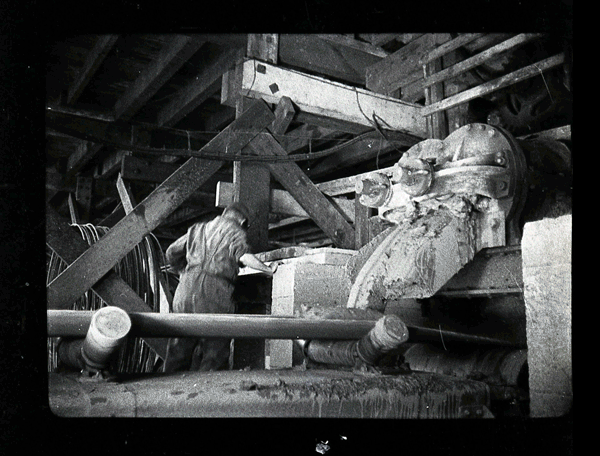

Another tasty gem are the camera slates that appear twice in the tin. Not only have we got "M.W.B." on this one but also the camera operators name and 'Prod' which could be the producer or production company? Squire & Barry. Getting shit done.
Random Rolls
Then there are a few anomalies.
The railway footage was solved pretty quickly. My Dad’s a Railwayman with a vast knowledge as well as the resource of countless other enthusiasts worldwide. The station turned out to be Euston in London and the viaduct is most likely Miller's Dale near Buxton.
But why?!
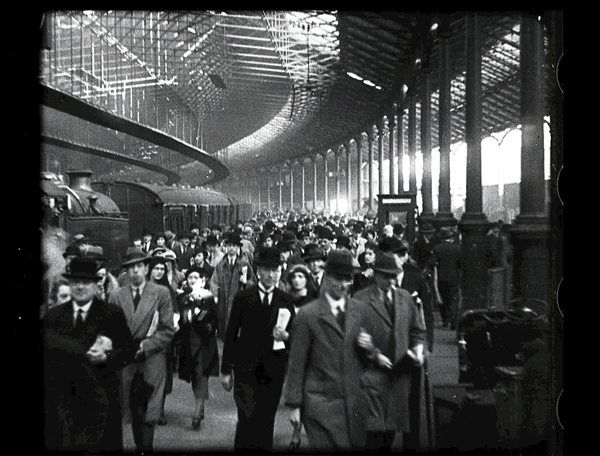
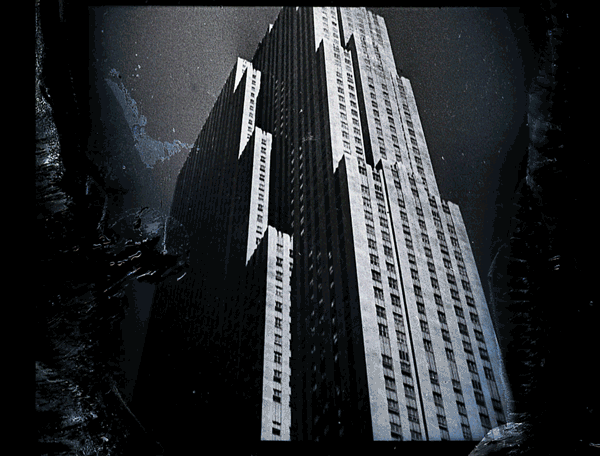
Papa Walden also had this building pegged as New York City’s Rockefeller Centre which I agree with.
But what’s the connection to the Metropolitan Water Board? Is there a connection or is the can just a container for random clips?
Then there’s the apparent dance marathon which stands out from the rest, not least of all because it’s a positive image rather than negative like the rest of the can.
Have you ever read They Shoot Horses Don’t They? It’s great. So is the film based upon it.
It’s a heartbreaking tale informed by the dance marathons of the depression-era U.S.A. I’m not sure if these contests were such a thing in the U.K. and the sponsor on the man’s back; MAR-DELLS, sounds more American to me than British. But this is all just opinion and not really based on anything.
Beautiful to watch though isn’t it.
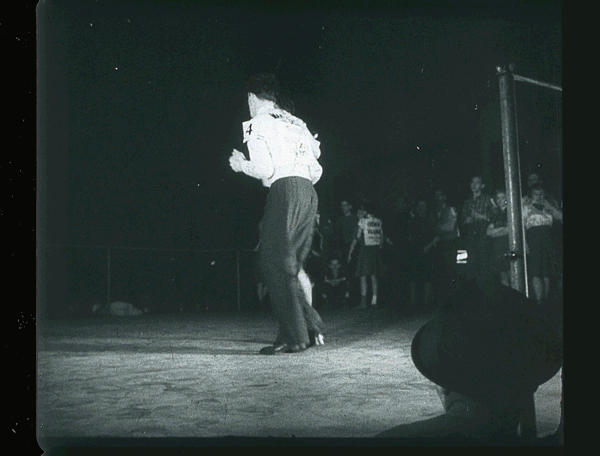

Toms Top Tin Tunes
You can watch the full narrative of the tin below.
The clips came out of the can, were scanned and that is the order shown in this edit.
The sixty-plus year old film is beautifully scored by the great, present-day Tom Adams.
I included the film and his music in my installation; "Lost & Found (first round)" which you can see more of on that page.
Thanks for reading this far if you did. If you didn't, nae bother.
Please get in touch if you have any information about any of the issues covered in tonight's programme. I'd love to hear from anyone with links to the M.W.B.
Links
